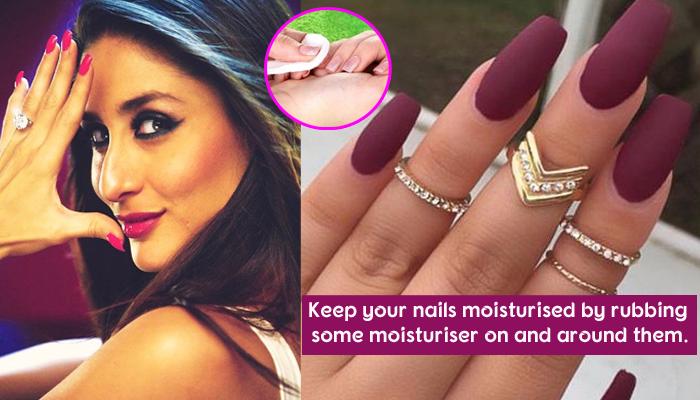


Earlier, we shared the real reasons behind acne breakouts in 7 spots, this time, we are here to speak about what the colour of your nails has to say about your health. Women are slightly more cautious and preoccupied with how our hair looks or if our skin is glowing enough or not. And most of the times, we end up ignoring about our fingernails unless we are changing our nail polish colour to match our dress or getting a manicure done.
Recommended Read: 15 Awesome Home Remedies To Make Your Nails Shiny And Healthy
Accept it or not, nails are not our top most priority. But it's time we take a generous look at your nails and observe the colour. Because, be it a tinge of white or slight discolouration, scales or bumps, nails do say a lot about your health. Here's a quick way to identify what your nails are trying to tell you about your health.
What it means: Contrary to what most people believe, white nails do not always indicate calcium or zinc deficiency. It is rather a minor nail trauma, usually harmless, caused to the nail plate when it grows.
What to do: If all the nails are white in entirety, you will have to undergo liver and kidney function tests. White nails can often be indicative of diabetes, cirrhosis or even heart problems. Psoriasis and eczema can also be the cause behind white spots on your nails.
What it means: Yellow nails indicate a fungal infection, but if the infection worsens, then it is a sure sign of respiratory disease, and in some cases, even thyroid, psoriasis or diabetes. Sometimes your nails turn yellow because of wearing nail polish for a longer period of time. So, there is no need to panic unless your nails are perennially yellow.
Also Read: The Science Behind Rubbing Fingernails Yoga That Stop Hair Loss And Grow Hair Fast
What to do: Give your nails a polish-free week. Also, always use a protective base coat before applying the nail paint. If you are a smoker, you can soak your nails in lime juice for 5 to 10 minutes and see the bleaching magic of lemon work on your discoloured nails. If your nails are yellow because of a fungal infection, see a doctor and get an oral anti-fungal medication.
What it means: Nails with a blue tinge hint at the improper circulation of oxygen in the blood, which can happen because of cold weather conditions or constriction in the blood vessels. In some cases, it may also indicate respiratory disease.
What to do: If your nails turn blue in cold conditions, try to keep yourself warm. However, if they remain blue perpetually, you should see a doctor to identify an underlying medical condition, perhaps for some breathing problem. Also, get your blood and oxygenation levels checked.
Also Read: 10 Easy Steps To Do A Perfect Manicure At Home
What it means: Pale nails may be a sign of conditions such as anaemia, congestive heart failure, liver disease, malnutrition and thyroid diseases. But, it can be an early sign of diabetes as well.
What to do: You must eat a wholesome diet, restrict sugar intake and eat yoghurt daily. Consume foods that are rich in iron, including beans, red meats and green leafy vegetables. Go for regular diabetes checks, if the pale nails become a persistent problem.
What it means: You have a condition called spoon nails when your nails begin to grow upwards taking a concave shape, almost looking like a spoon. It is a symptom of iron deficiency, which should not be ignored.
What to do: It may even be a warning sign of something more serious, such as a liver disease or heart disease or even hyperthyroidism. So, you must get the spoon nails investigated. If it is the anaemia, causing your nails to grow in this weird shape, then once the problem is corrected with proper diet, it will take a while for them to grow back in the normal way.
Also Read: 14 Things All Girls With Perfect Nails Do Every Day; Nail Care Tips For Beautiful Nails
What it means: Brittle nails tend to crack or split more often; the causes could either be prolonged contact with water or strong detergents. And, if your nails are white or yellow and have developed cracks beneath the nail plate, it could signify a fungal infection. Endocrine disorders, malnutrition, oral medications rich in vitamin A, psoriasis or TB could be other reasons or it can also be a sign of an under-active thyroid gland.
What to do: Keep your nails moisturised by rubbing some moisturiser on and around them. Start wearing gloves if you use a lot of soaps and chemicals. Trim your nails regularly. Also, add iron-rich foods to your diet. And, avoid too much exposure to water if your nails are excessively brittle.
Now take a good look at your nails and see if they need immediate medical attention because nails are as important as your eyes, radiant skin and sparkling white teeth. Stay tuned with us to know more about health and fitness.
Next Read: The Crazy Trend Of Dip Powder Nails Is Taking Over Gel And Acrylic Manicure